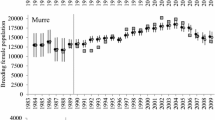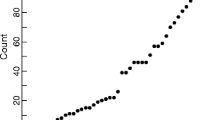Abstract
The development of simple models for describing the population dynamics of species with overlapping generations is briefly described. The paper then presents a minimally complex simulation model for tsetse populations in which seasonally varying density-independent mortality, generally applied only to the adult stage, is combined with density dependence acting on both puparia and adults. Density dependence regulates population size within limits determined by an interaction between the strength of the density-dependent relationships and the variability of the seasonal density independence. Population data sets for Glossina palpalis and G. morsitans in Nigeria, and G. pallidipes in Kenya are adequately described by the model. Relationships discovered between the density-independent mortality and climatic variables for the Lambwe Valley data set allow predictions of population changes in other siteson the basis of their climatic conditions. Attempts to predict changes in the population of G. pallidipes in Somalia highlight the difficulties of this exercise. A tsetse’s demographic response to climate may vary from region to region, making extensive predictions from local data sets difficult. There seems, however, no need to make more complex models to describe observed changes in tsetse populations.
Résumé
On a brièvement élaboré des modèles simples permettant de décrire la dynamique de la population des espèces avec des générations débordantes. Ensuite le mémoire présente un modèle complexe de simulation pour les populations de tsé-tsé dans lequel la mortalité indépendante de la densité saisonnière variable, généralement appliquée au stade adulte, est combiné avec la dépendance de densité agissant en même temps sur les larves et sur les adultes. La dépendance de densité règle le volume de la population au sein des limites déterminées par une interaction entre la force des relations de la densité dépendante et la variabilité de l’indépendance de la densité saisonnière. Les séries des donnés sur la population de Glossina palpalis et de G. morsitans au Nige’eria et celles de G. pallidipes au Kenya sont décrites de façon adéquate par le modèle. Les relations découvertes entre la mortalité indépendante de la densité et des variables climatiques pour la série des données de la Vallée de Lambwe, permet la suputation sur les changements dans d’autres sites sur base de leurs conditions climatiques. Les essais tendant à prédire les changements aus sein de la population de G. pallidipes en Somalie, révèlent les difficultés auxquelle se heurte cet exercise. La réaction démographique des tsé-tsé au climat peut varier d’une région à l’autre, rendant ainsi l’élaboration des prévisions à partir des données locales difficile. Il semble, cependant, qu’il n’y a pas besoin d’élaborer des modèles plus complexes pour décrire les changements observés dans les populations des mouches tsé-tsé.
Similar content being viewed by others
References
Allsopp R. (1985) Variation in the rates of increase of Glossina morsitans centralis and their relevance to control. J. Appl. Ecol. 22, 91–104.
Anderson R. M. (1982) Population Dynamics of Infectious Diseases. Chapman and Hall, London.
Anderson R. M. and May R. M. (1983) Vaccination against rubella and measles: quantitative investigations of different policies. J. Hyg., Cambridge 90, 259–325.
Anderson R. M. and May R. M. (1985) Herd immunity to helminth infection and implications for parasite control. Nature 315, 493–496.
Andrewartha H. G. and Birch L. C. (1956) The Distribution and Abundance of Animals. University of Chicago Press, Chicago.
Birley M. H. (1984) Estimation, tactics and disease transmission. In Pest and Pathogen Control: Strategic, Tactical and Policy Models (Edited by Conway G. R.), pp. 272–289. International Series on Applied Systems Analysis 13, Wiley, Chichester.
Bourn D. (1983) Tsetse control, agricultural expansion and environmental change in Nigeria. D.Phil. Thesis, Oxford University, U.K.
Buxton P. A. (1955) The Natural History of Tsetse Flies. Mem. 10, London School of Hygiene and Tropical Medicine. H. K. Lewis, London.
Caughley G. (1977) Analysis of Vertebrate Populations. Wiley, New York.
De Muynck A., and Rogers D. J. (1989) Workshop on Modelling Sleeping Sickness Epidemiology and Control. Ann. Soc. Belge Med. Trop. 69, Supplement 1, 1–256.
Dransfield R. D., Brightwell R., Kiilu J., Chaudhury M. F. and Adabie D. A. (1989) Size and mortality rates of Glossina pallidipes in the semi-arid zone of southwestern Kenya. Med. Vet. Entomol. 3, 83–95.
EATRO (1959) Annu. Rep. 1958. East African Trypanosomiasis Research Organization. EA High Commission, Nairobi 1959.
Hargrove J. W. (1988) Tsetse: The limits to population growth. Med. Vet. Entomol. 2, 203–217.
Hasseil M. P. (1978) The Dynamics of Arthropod Predator-Prey Systems. Princeton University Press, Princeton.
Hassell M. P. (1987) Detecting regulation in patchily distributed animal populations. J. Anim.Ecol. 56, 705–713.
Hassell M. P., Latto J. and May R. M. (1989) Seeing the wood for the trees: Detecting density dependence from existing life-table studies. J. Anim. Ecol. 58, 883–892.
Hassell M. P., Southwood T. R. E. and Reader P. (1987) The dynamics of the viburnum whitefly (Aleurotrachelus jelinekii): A case study of population regulation. J. Anim. Ecol. 56, 283–300.
HMSO (1958) Tables of Temperature, Relative Humidity and Precipitation for the World. Part IV. Africa, the Atlantic Ocean South of 35° North and Indian Ocean. HMSO, London.
Isherwood F. and Duffy B. J. (1959) The relation between nutritional status and apparent density of G. pallidipes. In EATRO 1959, pp. 58–59.
Jackson C. H. N. (1944) The analysis of a tsetse fly population II. Ann. Eugenics, Cambridge 12, 176–205.
Leslie P. H. (1959) The properties of a certain lag type of population growth and the influence of an external random factor on a number of such populations. Physiol. Zool. 32, 151–159.
May R. M. (1974) Stability and Complexity in Model Ecosystems. Princeton University Press, Princeton.
May R. M. (1984) Theoretical Ecology, 2nd edition. Blackwells, Oxford.
Maynard-Smith J. (1968) Mathematical Ideas in Biology. Cambridge University Press, Cambridge.
Onyiah J. (1978) Fluctuations in numbers and eventual collapse of a Glossina palpalis (R.-D.) population in Anara Forest Reserve of Nigeria. Acta Trop. 35, 253–261.
Pennycuick L. (1969) A computer model of the Oxford great tit population. J. Theor. Biol. 22, 381–400.
Phelps R. J. and Clarke G. P. Y. (1974) Seasonal elimination of some size classes in males of Glossina morsitans morsitans Westw. (Diptera, Glossinidae). Bull. entomol. Res. 64, 313–324.
Randolph S. E. and Rogers D. J. (1986) The use of discriminant analysis for the estimation of sampling biases for female tsetse. Ecol. Entomol. 11, 205–220.
Randolph S. E., Rogers D. J. and Kuzoe F. A. S. (1984) Local variation in the population dynamics of Glossina palpalis palpalis (Robineau-Desvoidy) (Diptera: Glossinidae). II. The effect of insecticidal spray programmes. Bull. entomol. Res. 74, 425–438.
Rogers D. J. (1974) Natural regulation and movement of tsetse fly populations. In Les Moyens de Lutte Contre les Trypanosomes et Leur Vecteurs, pp. 35–38. IEMVT, Paris.
Rogers D, J. (1979) Tsetse population dynamics and distribution: a new analytical approach. J. Anim. Ecol. 48, 825–849.
Rogers D. J. (1980) Dynamics and behaviour of tsetse populations. In Isotope and Radiation Research on Animal Diseases and Their Vectors. In Proc. Symp., Vienna, 7–11 May 1979, pp. 359–368. IAEA, Vienna.
Rogers D. J. (1983) Interpretation of sample data. In Pest and Vector Management in the Tropics (Edited by Youdeowei A. and Service M.), pp. 139–160. Longman, London.
Rogers D. J. (1984) The estimation of sampling biases for male tsetse. Insect Sci. Applic. 5, 369–373.
Rogers D. J. (1985) Trypanosomiasis “risk” or “challenge”: a review. Acta Trop. 42, 5–23.
RogersD. J. and Randolph S.E. (1984) A review of density-dependent processes in tsetse populations. Insect Sci. Applic. 5, 397–402.
Rogers D. J. and Randolph S. E. (1986) Distribution and abundance of tsetse flies (Glossina spp.). J. Anim. Ecol. 55, 1007–1025.
Rogers D. J. and Randolph S. E. (1990) Estimation of rates of predation on tsetse. Med. Vet. Entomol. 4, 195–204.
Ryan L. (1981) Glossina (Diptera: Glossinidae) population growth rates. Bull. entomol. Res. 71, 519–531.
Skellam J. G. (1966) Seasonal periodicity in theoretical population ecology. Proc. 5th Berkeley Symp. 4, 179–205.
Stiling P. (1988) Density-dependent processes and key factors in insect populations. J. Anim. Ecol. 57, 581–593.
Southwood T. R. E. and Reader P. (1976) Population census data and key factor analysis for the viburnum whitefly, Aleurotrachelus jelinekii. (Frauenf.) on three bushes. J. Anim. Ecol. 45, 313–325.
Southwood T. R. E., Hassell M. P., Reader P. and Rogers D. J. (1989) The population dynamics of the viburnum whitefly (Aleurotrachelus jelinekii). J. Anim. Ecol. 58, 921–942.
Taylor P. (1979) The construction of a life-table for Glossina morsitans morsitans Westwood (Diptera: Glossinidae) from seasonal age measurements of a wild population. Bull. entomol. Res. 69, 553–560.
Thompson W. R. (1931) On the reproduction of organisms with overlapping generations. Bull. entomol. Res. 22, 147–172.
Usher M. B. (1972) Developments in the Leslie Matrix model. In Mathematical Models in Ecology (Edited by Jeffers J. N. R.), pp. 29–60. British Ecol. Soc. Symp. No. 12. Blackwell Scientific Publications, Oxford.
Vale G. A. (1977) Feeding responses of tsetse flies (Diptera: Glossinidae) to stationary baits. Bull. entomol. Res. 67, 635–649.
Van Sickle J. (1988) Invalid estimates of the rate of population increase from Glossina (Diptera: Glossinidae) age distributions. Bull. entomol. Res. 78, 155–161.
Varley G. C., Gradwell G. R. and Hassell M. P. (1974) Insect Population Ecology. Blackwells, Oxford.
Verhulst P. F. (1838) Notice sur la loi que la population suit dans son accroissement. Corresp. Math. Phys. 10, 113–121.
Author information
Authors and Affiliations
Rights and permissions
About this article
Cite this article
Rogers, D.J. A General Model for Tsetse Populations. Int J Trop Insect Sci 11, 331–346 (1990). https://doi.org/10.1017/S1742758400012753
Received:
Published:
Issue Date:
DOI: https://doi.org/10.1017/S1742758400012753




